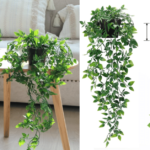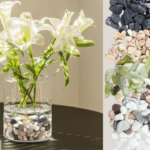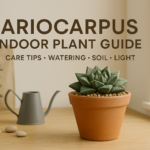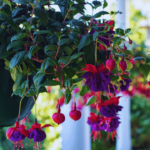Have you ever looked up at a blank ceiling and thought it could be transformed into a canvas for greenery? Hanging plants from the ceiling is not just a trend but an innovative way to bring nature indoors, adding vibrancy and character to any space. In this article, we’ll explore everything you need to know about why to hang a plant from the ceiling—from selecting the right materials to executing a flawless installation, and even creative ways to showcase your indoor garden.
Hanging plants are more than a decorative statement; they are a lifestyle choice that enhances both the aesthetic appeal and functionality of your living environment. Let’s dive into the reasons why you might want to consider this creative endeavor.
Benefits for Your Living Space

When you hang a plant from your ceiling, you not only save floor space but also create a focal point that brings nature indoors. It’s a clever way to infuse a room with life, adding color, texture, and a sense of calm. Whether you live in a small apartment or a spacious home, hanging plants can be arranged to suit any layout.
Enhancing Aesthetics and Ambiance
Picture yourself entering a room with cascading greenery that seems to float effortlessly from the ceiling. This captivating visual can transform a mundane space into a lush oasis, perfect for relaxation or entertaining guests. The natural element of plants combined with modern design can elevate your interior décor to a new level of sophistication and charm.
Materials and Tools Needed
Before you embark on your hanging plant project, it’s essential to gather the right materials and tools. Being prepared will ensure a smooth installation process and reduce the chances of mishaps.
Essential Tools for the Job
- Ceiling Hooks: Ensure they are rated for the weight of your plant and planter.
- Screwdriver/Drill: For securing hooks into the ceiling.
- Measuring Tape: To accurately measure distances and positions.
- Pencil or Marker: For marking the exact spots on your ceiling.
- Ladder: To reach high spots safely.
- Stud Finder: To locate ceiling beams or support structures if needed.
Types of Planters and Hanging Devices
There is a variety of planters to choose from, each offering its unique style:
- Macramé Hangers: These bring a bohemian flair to your décor.
- Metal or Wire Baskets: Perfect for a modern industrial look.
- Ceramic Planters: For a sleek and refined aesthetic.
- Self-Watering Planters: Ideal for those who might occasionally forget to water their greenery.
Assessing Your Ceiling
Not all ceilings are created equal, so it’s vital to assess your ceiling’s structure before hanging a plant. Your ceiling’s material and its load-bearing capacity are crucial factors for a safe installation.
Identifying the Type of Ceiling
Ceilings can be made of drywall, plaster, or exposed beams. Each material has different requirements:
- Drywall: Often requires the use of anchors to support the weight.
- Plaster: May need specialized hooks to prevent cracking.
- Beams or Exposed Ceilings: Offer natural support and usually don’t require additional reinforcements.
Understanding Load-Bearing Requirements

It’s important to know how much weight your ceiling can support. Always opt for hardware that can handle more than the expected load of your plant, planter, and any additional accessories. If in doubt, consult a professional to ensure safety.
Safety Precautions Before Installation
Before drilling any holes, make sure you have turned off any nearby electrical fixtures to avoid accidents. Using a stud finder can help you locate a secure point for the hook installation, reducing the risk of damaging the ceiling or causing injury.
Planning Your Hanging Plant Location
Choosing the perfect spot for your hanging plant is as important as the installation process itself. Here are a few pointers to help you decide on the ideal location.
Selecting the Best Spot in Your Room
Think about where you want the plant to be visible. A well-placed hanging plant can create a dynamic visual impact and even serve as a natural room divider. Consider spaces like entryways, living rooms, or even a cozy reading nook.
Considering Sunlight and Environmental Factors
Plants need sunlight to thrive, so choose a location that receives adequate light. If your chosen spot is in a dim corner, opt for low-light tolerant plants or consider using supplemental grow lights. Additionally, think about the airflow and temperature of the room, as these factors can affect the health of your plant.
Step-by-Step Guide to Hanging a Plant

Now that you’ve prepared by gathering materials and selecting the right spot, let’s break down the process into clear, manageable steps.
Step 1: Measuring and Marking
Begin by measuring the space where you plan to hang your plant. Use a measuring tape to determine the optimal height and distance from surrounding objects. Mark the spot lightly with a pencil or marker. This will serve as your guide for where to drill and install the hook.
Step 2: Installing the Ceiling Hook
Once you’ve marked the spot, it’s time to install the hook:
- Choose a hook that is rated for the weight of your plant and planter.
- If you’re working with drywall, use an anchor to secure the hook properly.
- Drill a pilot hole at the marked spot, then insert the hook securely. Test the hook by gently tugging to ensure it’s firmly in place.
Step 3: Securing the Hanging Chain or Rope
Next, attach your chain or rope to the hook:
- Measure the desired length of your rope or chain, considering the final height you want for your plant.
- Tie secure knots or use hardware designed for hanging objects.
- Double-check the connection to ensure that it is tight and will hold up over time.
Step 4: Attaching the Planter
Finally, it’s time to attach your planter:
- Most planters come with a built-in loop or mechanism for hanging. If not, you may need to use additional hardware.
- Gently lower the planter onto the rope or chain and ensure it hangs evenly.
- Adjust the length if necessary to achieve the desired height.
Safety Considerations
Safety is paramount when hanging a plant from the ceiling. Here are some tips to ensure that your installation remains secure and that your space stays safe:
Weight Distribution and Load Capacity
Avoid overloading your ceiling by ensuring that the combined weight of the plant, soil, and planter does not exceed the rated capacity of your chosen hardware. Spread the weight evenly, and if you plan to hang multiple plants in one area, consider reinforcing the ceiling or installing additional support.
Tips to Avoid Accidents and Damage
- Always double-check all connections and hardware.
- Avoid placing hanging plants near areas where people frequently walk or gather.
- If your ceiling is not designed to support extra weight, consider alternative locations or consult a professional.
Care and Maintenance of Your Hanging Plant
Hanging your plant is just the beginning. To keep it healthy and vibrant, ongoing care and maintenance are essential.Proper care and maintenance are essential to keep your hanging plants healthy and thriving. Below are key aspects to consider:
1. Watering
- Use a long-spout watering can or a spray bottle for easier access.
- Water slowly to avoid overflow and dripping onto the floor.
- Ensure the planter has drainage holes to prevent root rot.
- Consider using a self-watering hanging planter for convenience.
2. Light Requirements
- Place the plant in a location that provides suitable light conditions for its species.
- Rotate the plant occasionally to ensure even light exposure.
- If the plant doesn’t get enough natural light, use grow lights.
3. Humidity and Air Circulation
- Mist the plant regularly if it requires high humidity (e.g., ferns, orchids).
- Avoid placing plants near heating vents or air conditioners that may dry them out.
- Ensure good air circulation to prevent fungal issues.
4. Fertilizing
- Use a diluted liquid fertilizer once every 2-4 weeks during the growing season.
- Choose a fertilizer suitable for the plant type (e.g., flowering plants, leafy greens).
- Reduce feeding during winter when plant growth slows down.
5. Pruning and Trimming
- Trim dead or yellowing leaves to encourage new growth.
- Prune trailing plants to maintain their desired shape and size.
- Remove spent flowers to promote continuous blooming.
6. Pest Control
- Inspect leaves regularly for pests like spider mites, aphids, or mealybugs.
- Use neem oil or insecticidal soap for natural pest control.
- Keep the plant clean by wiping leaves with a damp cloth.
7. Cleaning and Maintenance of the Planter
- Remove dust and debris from the planter to maintain its appearance.
- Check hanging hooks and supports regularly for stability and wear.
- Ensure the plant is securely positioned to avoid accidents.
Adjustments and Seasonal Care
Hanging plants require different care throughout the year as seasons change. Here’s how you can adjust their care to ensure they stay healthy year-round.
1. Spring Care: Encouraging New Growth
- Increase watering as plants enter their active growth phase.
- Begin regular fertilizing (every 2-4 weeks) to support new leaves and blooms.
- Repot if necessary to give the roots more space and refresh the soil.
- Trim away any dead or weak growth from winter dormancy.
2. Summer Care: Protecting from Heat and Sun
- Water more frequently, especially for thirsty plants like ferns and ivy.
- Keep plants shaded if exposed to direct sunlight for long hours.
- Check for pests, as warmer months bring insects like spider mites and aphids.
- Ensure proper air circulation to prevent fungal growth in humid conditions.
3. Autumn Care: Preparing for Dormancy
- Gradually reduce watering as plant growth slows down.
- Cut back on fertilizing, as plants need fewer nutrients.
- Inspect and clean leaves to remove dust and pests before winter.
- Move tropical plants indoors if outdoor temperatures start dropping.
4. Winter Care: Managing Dry Air and Low Light
- Reduce watering to prevent overwatering and root rot.
- Increase humidity by misting or placing a tray of water near the plant.
- Move plants closer to windows for natural light or use grow lights.
- Keep plants away from cold drafts, heaters, and fireplaces that dry out the air.
5. Regular Adjustments Based on Environment
- Rotate the plant to ensure even light exposure.
- Check hanging hardware for stability and safety.
- Dust leaves occasionally to allow for better photosynthesis.
Common Mistakes and How to Avoid Them
Even experienced DIY enthusiasts can run into a few pitfalls when hanging a plant. Here are some common mistakes and tips on how to avoid them:
Overloading Your Ceiling
One of the most frequent errors is attaching too much weight for the ceiling’s capacity. Always check the manufacturer’s guidelines on your hardware and, when in doubt, err on the side of caution.
Incorrect Installation Techniques
Improper installation can lead to sagging planters or, worse, accidents. Ensure that you:
- Use the correct drill bit for your ceiling material.
- Secure the hook into a stud or use proper anchors.
- Test the stability of your setup before fully committing to the installation.
Creative Ideas for Displaying Hanging Plants
Once your plant is securely hanging, the creative possibilities are endless. Use your newfound DIY skills to create a beautiful and unique display.
Grouping Techniques for Visual Impact
Consider creating a mini indoor garden by hanging multiple plants at varying heights. This technique can add depth and movement to your space. Grouping different types of plants—such as trailing vines with upright foliage—can create a harmonious blend of textures and colors.
Incorporating Decorative Elements
Enhance the overall aesthetic by integrating decorative elements:
- Use stylish macramé hangers or custom-painted planters.
- Add fairy lights around the hanging plants for a magical glow in the evenings.
- Incorporate seasonal decorations that complement your plant’s natural beauty.
Indoor vs. Outdoor Hanging Plants
While hanging plants are fantastic for indoor spaces, they can also work beautifully outdoors with a few adjustments.
Special Considerations for Indoor Settings
For indoor plants, pay attention to:
- The level of natural light available.
- Indoor temperature and humidity levels.
- Potential hazards such as pets or children who might disturb the hanging arrangement.
Adjustments for Outdoor Installations
Outdoor hanging plants may require:
- Weather-resistant hardware that can withstand rain and wind.
- Regular maintenance to prevent rust and degradation of materials.
- Positioning in sheltered spots to avoid direct exposure to harsh elements.
Troubleshooting Installation Issues
Even with careful planning, you might encounter minor issues along the way. Here are solutions to some common problems:
Addressing Sagging or Unstable Planters
If you notice your planter beginning to sag or wobble, check the following:
- Ensure the hook and anchors are firmly secured.
- Verify that the weight of the plant is evenly distributed.
- Consider reinforcing the connection or using additional support if necessary.
Repairing Minor Ceiling Damages
In the unlikely event that your installation causes minor damage to your ceiling:
- Use a patch kit or spackle to repair small holes.
- For larger damages, it may be best to consult a professional.
- Regularly inspect the area around your hanging plant to catch any issues early.
Enhancing Your Space with Hanging Plants
Hanging plants have the unique ability to transform a space by drawing the eye upward and creating a sense of balance. Whether you’re decorating a modern loft or a cozy home, hanging plants can serve as a statement piece that complements your existing décor.
Complementing Various Interior Design Styles
- Modern Minimalist: Use sleek, geometric planters with clean lines.
- Bohemian Chic: Opt for colorful macramé hangers and eclectic planters.
- Rustic Farmhouse: Choose wooden or woven baskets to enhance the cozy, natural feel.
- Industrial: Metallic fixtures paired with lush greenery create a striking contrast.
Utilizing Hanging Plants to Define Spaces
Hanging plants can also be used as a visual divider in open-concept spaces. They create distinct areas without the need for permanent walls, lending a fluid and dynamic feel to your home design. Think of them as nature’s drawing boundaries while maintaining an open and airy atmosphere.
Conclusion
Hanging a plant from the ceiling is more than just a DIY project—it’s a creative journey that brings a touch of nature into your living space. By following our step-by-step guide, selecting the right materials, and paying close attention to safety, you can transform any room into a green oasis. Remember, the key to success lies in proper planning and regular care. Whether you’re an experienced DIYer or a beginner, the process is simple, rewarding, and incredibly stylish. So why not give it a try and let your ceiling bloom with life?
FAQs
1. What types of ceilings are best for hanging plants?
Ceilings with exposed beams or those made of sturdy materials like solid wood or reinforced drywall work best. Always use appropriate anchors if you are unsure about the load-bearing capacity.
2. How do I know if my ceiling can support a hanging plant?
If you’re using drywall, use a stud finder to locate a support beam or consider using specialized anchors rated for heavier loads. When in doubt, consult a professional for guidance.
3. Can I hang multiple plants from one ceiling?
Yes, but ensure that each hook is securely installed and that the total weight does not exceed the ceiling’s load capacity. Grouping lighter plants can create a beautiful display without risking structural integrity.
4. How often should I water a hanging plant?
Watering frequency depends on the type of plant, its size, and the environment. Typically, hanging plants need watering once the top inch of soil feels dry. Self-watering planters can help maintain a consistent moisture level.
5. What are some creative ways to display hanging plants?
Consider grouping different plants at varying heights, using decorative macramé hangers, or even incorporating fairy lights around your hanging arrangement to create a warm, inviting ambiance.







